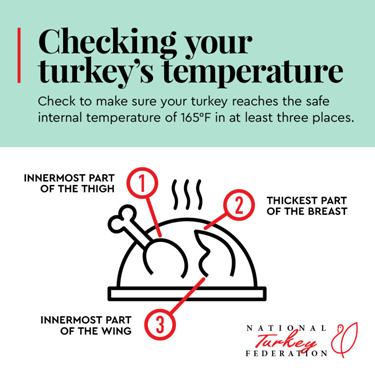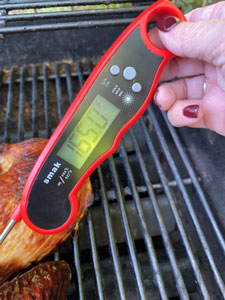Indulge in the succulent flavors of a perfectly smoked turkey! This guide will equip you with the essential knowledge on smoked turkey thermometer placement, ensuring a juicy, flavorful, and safe culinary masterpiece
Mastering the Art of Smoked Turkey Thermometer Placement:
1. Embrace the Three-Point Approach:
For an accurate temperature reading, insert the thermometer into three crucial locations:
- The thickest portion of the turkey breast: Aim for the innermost part, avoiding bone or gristle.
- The innermost portion of the thigh: Locate the thickest area, ensuring the thermometer doesn’t touch bone.
- The innermost portion of the wing: Find the thickest area, avoiding contact with bone.
2. Side Insertion for Enhanced Accuracy:
When inserting the thermometer into a turkey breast or ground turkey patty, opt for a side insertion. This method provides a more accurate reading and facilitates easier reading.
3 Achieving the Perfect Internal Temperature:
The internal temperature of your smoked turkey, including any stuffing, should reach a minimum of 165°F. This temperature ensures the elimination of harmful bacteria, guaranteeing a safe and delicious meal.
4. Thermometer Selection: Your Culinary Allies:
a) Oven-proof Thermometers:
These thermometers remain inserted throughout the cooking process, providing a continuous temperature reading. Ideal for whole turkeys and turkey breasts.
b) Instant-read and Digital Thermometers:
These thermometers offer rapid and accurate temperature readings. For optimal use, pull the turkey out of the smoker, insert the thermometer into the thickest part of the meat (avoiding bone or the pan), and wait for a stable reading.
c) Pop-up Thermometers:
Commonly found in pre-packaged turkeys, these thermometers indicate when the turkey has reached the safe internal temperature. However, experts recommend verifying the temperature with a conventional thermometer for added assurance.
5. Thermometer Hygiene: Maintaining a Clean and Safe Cooking Environment:
a) Cleaning:
Wash your thermometer thoroughly with hot, soapy water after each use.
b) Sanitizing:
Choose one of the following methods to sanitize your thermometer:
- Alcohol swab: Wipe the stem with an alcohol swab.
- Food-safe sanitizing solution: Prepare a diluted bleach solution according to the instructions on the bottle and immerse the stem for at least 10 seconds.
- Boiling water: Submerge the stem in boiling water for at least 30 seconds.
c) Residue Removal:
After using alcohol or a cleaning solution, wash the stem with soap and hot water to remove any residue.
6. Thermometer Accuracy: Ensuring Reliable Readings:
a) Calibration:
Calibrate your thermometer upon purchase and regularly thereafter. Accuracy can be affected by extreme temperature changes or drops.
b) Ice-point Method:
Prepare a 50/50 ice-water mixture and insert the thermometer stem, ensuring the tip is fully submerged but not touching the cup’s sides or bottom. After five minutes, the reading should be 32°F. If not, adjust the thermometer.
c) Boiling Point Method:
Fill a pan with three inches of water and bring to a rolling boil. Insert the thermometer stem, ensuring the tip is fully submerged but not touching the pan’s sides or bottom. After one minute, the reading should be 212°F (adjust for altitude). If not, adjust the thermometer.
7. Embrace the Journey: Tips and Tricks for Smoked Turkey Perfection:
- Brining: Enhance the flavor and moisture of your turkey by brining it for 12-24 hours before smoking.
- Seasoning: Experiment with different rubs and marinades to create unique flavor profiles.
- Wood Selection: Choose wood chips or chunks that complement the flavor of your turkey. Popular options include hickory, apple, and mesquite.
- Smoking Temperature: Maintain a consistent smoking temperature between 225°F and 275°F.
- Resting: Allow the smoked turkey to rest for at least 20 minutes before carving. This allows the juices to redistribute, resulting in a more tender and flavorful bird.
8. Frequently Asked Questions:
a) What type of thermometer is best for smoked turkey?
Instant-read or digital thermometers are preferred for their speed and accuracy. However, oven-proof thermometers are also suitable for whole turkeys and turkey breasts.
b) How long should I smoke a turkey?
The smoking time depends on the weight of the turkey and the desired level of doneness. Generally, allow 30-45 minutes per pound for a fully cooked turkey.
c) What internal temperature should I aim for when smoking a turkey?
The internal temperature of the turkey, including any stuffing, should reach 165°F.
d) Can I use a pop-up thermometer for smoked turkey?
Pop-up thermometers can be used as an indication of doneness, but it’s always recommended to verify the temperature with a conventional thermometer for accuracy.
9. Additional Resources:
- National Turkey Federation: https://www.eatturkey.org/
- USDA Food Safety and Inspection Service: https://www.fsis.usda.gov/
- Weber Grills: https://www.weber.com/US/en/
By mastering smoked turkey thermometer placement and following these guidelines, you’ll be well on your way to creating a juicy, flavorful, and perfectly cooked smoked turkey that will impress your family and friends.
Where to Put the Thermometer in a Turkey

An important part of using any thermometer is the proper placement in the turkey. Unsure of where to put the thermometer in a turkey? Here are few tips to keep in mind:
- Place the thermometer into the thickest part of the turkey breast, the innermost part of the thigh, and the innermost part of the wing when cooking an entire turkey.
- Ensure that the thermometer stays away from the pan, bone, or gristle.
- The thermometer should be inserted from the side into a ground turkey patty or turkey breast. Compared to when it is inserted from the top, the thermometer is more accurate and easier to read.
The internal temperature of your turkey (and any stuffing) should always reach 165°F.

According to the U. S. Food and Drug Administration reports that from 49% in 1998 to 70% in 2010, more consumers now own food thermometers. Utilizing a meat thermometer is advised by the USDA and the National Turkey Federation to guarantee a tasty and secure dinner.
Accurate temperatures, both in the oven and the turkey are important for quality and safety. A meat thermometer is a cook’s best friend when it comes time to prepare a meal.
Meat thermometers that can be calibrated for accuracy and instant-read/digital thermometers are our preferred choices. These types of thermometers are available at grocery, kitchen and hardware stores.
Don’t forget about your oven’s temperature! Check the oven thermostat and oven temperature to verify the oven setting. Recalibrate if necessary – a 25°F variation can make a 5 percent difference in cooked turkey yield. An oven that is too hot will dry and shrink the bird.
Check out USDA’s resource for more information on proper cooking temperatures.
This needs to be placed inside the turkey at the start of cooking and left inside the bird the entire time it is cooking. The temperature indicator will rise slowly as the turkey cooks. An oven-proof thermometer is ideal for the whole turkey and the turkey breast.
With the help of these thermometers, you can quickly and accurately determine the internal temperature of meat. They are not designed to stay in the food during cooking. If using this kind, remove the turkey from the oven just far enough to allow the stem to go about 2 1/2 inches into the thickest area of the meat without coming into contact with the roasting pan or the bone.
The tiny indentation that serves as the sensing tip is situated approximately 1 1/2 inches from the stem’s end and needs to be completely inserted into the bird. (Look for a tiny dimple on the stem. ) The temperature should register in about 15-20 seconds. Wipe with a sanitizer after each use and before the next use.
These are commonly found in the whole turkey and turkey breast. The “pop-up” thermometer device indicates the turkey has reached the final temperature for safety and doneness. Experts suggest the temperature be verified with a conventional thermometer.
USDA has a full listing of the various types of food thermometers available.
Food thermometers should be washed following use with hot soapy water and sanitized. Most thermometers, particularly digital and instant-read varieties, should not be immersed in water.
There are several ways to sanitize your thermometer:
- Use an alcohol swab to wipe the stem.
- Utilize a food-safe disinfectant, like a mixture of water and chlorine bleach, diluted as per the bottle’s instructions, and immerse it in the diluted mixture for a minimum of 10 seconds.
- Submerge the stem into boiling water for a minimum of 30 seconds.
Make sure to wash the stem with soap and hot water after using alcohol or a cleaning solution to get rid of any residue.
